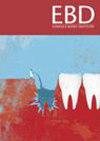金属基抗菌凝胶是当代牙髓学消毒的潜在替代品吗?
IF 2.3
Q3 Dentistry
引用次数: 0
摘要
目的:本研究旨在评估一种新型抗菌凝胶的有效性,该凝胶含有铜和银纳米颗粒,用于根管消毒。方法:使用生物相容性聚合物的支持网络,包括聚乙烯醇(PVA)、聚乙烯醇吡罗烷酮(PVP)和聚乙二醇(PEG),在内部创建铜基和银基凝胶。我们创建了6个实验组,其中3个含银离子,3个含铜离子,每组还调整PVA、PVP和PEG的比例,以测试凝胶的物理状态。一组不含金属纳米颗粒。通过原子力显微镜、扫描电子显微镜、透射电子显微镜和流变仪对凝胶的表面特征、粗糙度、机械性能和流动性进行了表征。进一步的生物学测试测量了凝胶的细胞毒性水平,使用人类牙周韧带细胞,以及对粪肠杆菌和多物种细菌生物膜的抑菌作用。结果:每种凝胶都表现出高水平的粘度,在含有降低的PVA浓度的凝胶中粘度降低。溶解度高、孔隙率低、表面粗糙度降低的凝胶,其整体抗菌性能提高。与银相比,铜纳米颗粒对粪肠球菌明显更有效。含有较高PVA水平的凝胶和银纳米颗粒对人体细胞具有更大的毒性水平,然而,由于凝胶在测量之前溶解,因此无法对大多数实验组进行测试。所有凝胶制剂的抗菌性能都明显低于次氯酸钠(1 h后),但与氢氧化钙(7天后)相比,结果相似。结论:抗菌凝胶的开发高度依赖于许多成分因素,其中开发仍处于早期阶段。与对人体细胞毒性更高的银相比,铜纳米颗粒似乎更适合用于运河消毒。为生物相容性聚合物选择的比例对物理状态、抗菌和毒性水平有关键影响。目前,抗菌凝胶的效果不如次氯酸钠。本文章由计算机程序翻译,如有差异,请以英文原文为准。
Are metal-based antibacterial gels a potential alternative for disinfection in contemporary endodontics?
This study aimed to assess the effectiveness of a novel antimicrobial gel, containing copper and silver nanoparticles, for use in root canal disinfection. Copper and silver-based gels were created in-house, using a support network of biocompatible polymers, including polyvinyl alcohol (PVA), polyvinyl pyrrolidone (PVP), and polyethylene glycol (PEG). Six experimental groups were created, three containing silver ions and three copper ions, where the PVA, PVP and PEG ratios were also adjusted in each group to test the gel’s physical state. One control contained no metal nanoparticles. The gels surface characteristics, roughness, mechanical properties, and flowability, were characterised using a combination of atomic force microscopy, scanning electron microscopy, transmission electron microscopy and Rheometery. Further biological testing measured the gels cytotoxicity levels, using human periodontal ligament cells, and the anti-microbial effects against E. Faecalis and a multi-species bacteria biofilm. Each gel demonstrated high levels of viscosity, which was lowered in gels containing a reduced PVA concentration. The overall antimicrobial properties of the gels increased in those with a higher dissolution, lower porosity, and reduced surface roughness. Copper nanoparticles were shown to be significantly more effective against E. Faecalis, compared with silver. Gels containing higher PVA levels, and silver nanoparticles, had greater toxicity levels against human cells, however, testing was not possible for most experimental groups as the gels dissolved before measurements took place. The antimicrobial properties of all gel formulations were significantly less effective than sodium hypochlorite (after 1 h), but a similar outcome was detected in comparison with calcium hydroxide (after 7 days). Developing an antimicrobial gel is highly dependent upon numerous compositional factors, where development is still at the early stages. The use of copper nanoparticles appeared to be more appropriate for use in canal disinfection, compared with silver that also had higher levels of human cell toxicity. The ratios selected for the biocompatible polymers had a critical impact on the physical state, antimicrobial, and toxicity levels. At present, antimicrobial gels are not as effective as sodium hypochlorite.
求助全文
通过发布文献求助,成功后即可免费获取论文全文。
去求助
来源期刊

Evidence-based dentistry
Dentistry-Dentistry (all)
CiteScore
2.50
自引率
0.00%
发文量
77
期刊介绍:
Evidence-Based Dentistry delivers the best available evidence on the latest developments in oral health. We evaluate the evidence and provide guidance concerning the value of the author''s conclusions. We keep dentistry up to date with new approaches, exploring a wide range of the latest developments through an accessible expert commentary. Original papers and relevant publications are condensed into digestible summaries, drawing attention to the current methods and findings. We are a central resource for the most cutting edge and relevant issues concerning the evidence-based approach in dentistry today. Evidence-Based Dentistry is published by Springer Nature on behalf of the British Dental Association.
 求助内容:
求助内容: 应助结果提醒方式:
应助结果提醒方式:


